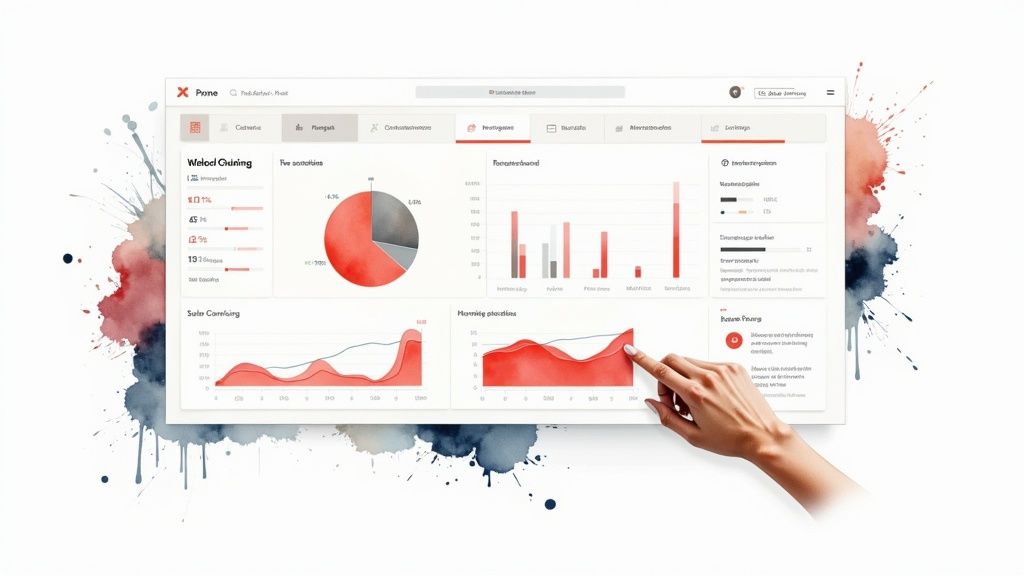How to Manage Multiple Projects and Stay Sane
Max
The real secret to juggling multiple projects isn’t about becoming a superhuman multitasker. It’s about creating a single source of truth.
Think of it as building a centralized dashboard—a ‘Master Plan’—that gives you a bird’s-eye view of every single initiative you’re running. When you centralize everything first, you stop wasting precious mental energy on context switching and start making smart, strategic decisions.
Build Your Command Center
Trying to manage multiple projects at once often feels like spinning plates. You know the feeling—the second you look away from one, you’re sure another is about to come crashing down. That constant shuffle between different tasks, deadlines, and teams is mentally draining and a perfect recipe for costly mistakes. The problem isn’t that you’re not working hard enough; it’s that you lack a single, unified perspective.
A single source of truth is your command center. This is way more than just another to-do list; it’s a high-level dashboard where you can see all project statuses, critical deadlines, and who’s working on what, all in one place. It puts an end to digging through endless emails, messy spreadsheets, and a dozen different apps just to get the big picture.
In fact, with around 85% of project managers juggling multiple projects at the same time, a centralized system isn’t just a nice-to-have, it’s essential for survival.
The benefits of setting up this command center are pretty much immediate:
- Total Visibility: You can instantly spot which projects are cruising along, which are flashing red, and where your team members might be overextended.
- Reduced Mental Load: By getting all the project details out of your head and into a system, you free up your brain to focus on actual problem-solving and strategy, not just remembering what’s next.
- Smarter Decision-Making: When you have a clear, real-time overview, you can make informed calls about priorities and resource shifts based on actual data, not just gut feelings.
Core Components of a Multi-Project Master Plan
Building your command center requires a few key ingredients. This table breaks down the essential components that form the backbone of an effective multi-project management system.
| Component | Purpose | Example Action |
|---|---|---|
| High-Level Timelines | To visualize key milestones and deadlines for all projects on a single calendar or Gantt chart. | Plot the launch dates for Project A, B, and C to see them relative to each other. |
| Resource Allocation | To see who is assigned to which tasks across all projects, preventing overloads and burnout. | Create a view showing that your lead designer is booked for two major tasks next week. |
| Centralized Task List | To aggregate all individual tasks from every project into one master view, filterable by project. | Pull all “In Progress” tasks from every team’s board into a single dashboard widget. |
| Risk & Blocker Log | To track potential issues, dependencies, and roadblocks that could impact any of the projects. | Flag a potential budget overrun in Project B that might delay hiring for Project D. |
| Status Dashboard | To provide a quick, at-a-glance summary of each project’s health (e.g., On Track, At Risk, Delayed). | Use color-coded statuses (Green, Yellow, Red) for each project on your main screen. |
With these elements in place, you move from being a reactive manager to a proactive leader, steering your projects with clarity and confidence.
A Real-World Scenario
Let me paint a picture for you. Imagine a marketing director, Sarah, who’s simultaneously running a huge product launch, a complex website migration, and a full company re-branding. At first, she was completely overwhelmed. Each project team was off in its own world, with crucial information scattered across Slack channels, different Asana boards, and a maze of Google Docs. Getting a sense of the overall progress was impossible.
To get a grip on the chaos, Sarah built a simple ‘Master Plan’ in her project management tool. It wasn’t anything fancy, but it had:
- A high-level timeline showing the major milestones for all three initiatives.
- A resource allocation view so she could see exactly who was working on what, and when.
- A risk register that immediately flagged potential conflicts—like her top designers being double-booked for the re-brand and the product launch in the same week.
By pulling everything into one place, Sarah spotted that resource conflict instantly and was able to adjust the timelines before it became a crisis. She went from constantly putting out fires to strategically steering her projects toward the finish line.
To truly nail this, it helps to understand exactly how a single source of truth for data can unlock growth across your entire organization. This principle is also fundamental to smart remote workforce management, a topic we cover in depth in our guide.
Choosing the Right Tools for Your Workflow

Your entire strategy for juggling multiple projects lives or dies by the tools you use. Without the right software, even the most beautifully organized command center can crumble into a mess of chaotic spreadsheets and lost email threads. The goal isn’t just to pick a tool; it’s to build a tech stack that brings clarity, centralizes chatter, and keeps things updated automatically so you can focus on actually moving work forward.
This is where so many teams get tripped up. The project management software market is booming, expected to hit USD 12.02 billion by 2030, yet a shocking 77% of organizations are still stuck using clunky spreadsheets and email. If you want to dig into the numbers, you can find more current project management statistics on thebusinessdive.com.
Picking the right platform is non-negotiable for anyone trying to manage multiple projects, especially with a distributed team. Don’t let your system become part of the problem.
Identifying Your Core Needs
Before you fall down a rabbit hole of feature comparisons, stop and figure out what you actually need a tool to do. Every team’s needs are unique. A five-person design agency operates completely differently than a 50-person engineering department.
Start by asking yourself a few pointed questions:
- What’s our single biggest headache right now? Are deadlines slipping through the cracks? Is communication a disaster? Are you constantly dealing with resource conflicts or stakeholders who have no idea what’s going on?
- How gnarly are our projects? Do you just need a glorified to-do list, or are you deep in the weeds with Gantt charts, complex dependencies, and detailed reporting?
- How does our team actually collaborate? Are you a high-chatter group, or do you need a tool that supports focused, asynchronous work across multiple time zones?
- What other software is already in the mix? Your project management tool has to play nice with the rest of your stack, whether that’s Slack, Google Drive, or your CRM.
Answering these questions first gives you a scorecard to measure potential tools against. It stops you from getting distracted by flashy features you’ll literally never use.
Essential Features for a Multi-Project View
Generic project management software can feel like you’re trying to hammer in a screw when you’re managing several initiatives at once. To get a true bird’s-eye view of your entire workload, you need features built specifically for seeing the bigger picture.
Here’s what I always look for:
Aggregated Dashboards: This is your command center. You absolutely need a main screen that pulls in the critical data—status, deadlines, owners—from all your projects into one clean, scannable view. Tools like Asana do this really well with their “Portfolios” feature.
Resource Allocation Views: To head off burnout and spot bottlenecks before they happen, you need to see who’s working on what across every single project. Look for tools with a “Workload” or “Capacity Planning” feature that shows you visually if someone is swamped or sitting on their hands.
Cross-Project Dependencies: This one’s a bit more advanced, but it’s a lifesaver for complex, interconnected work. When a delay in Project A is going to torpedo Project B, you need the ability to link those tasks across different project boards. You’ll find this in more powerful tools like Jira or ClickUp.
The best tool isn’t the one with the most bells and whistles; it’s the one that gives your team the clearest, most intuitive path to getting work done. Simplicity often beats complexity.
A Practical Example: Customizing Trello
You don’t always need to shell out for a heavy-duty, expensive platform. I once worked with a small agency that was completely overwhelmed trying to track client work. They had a separate Trello board for each client, and the owner was flying blind with no unified view of anything. Predictably, tasks were falling through the cracks left and right.
Instead of migrating them to a complex new system, we just supercharged the Trello setup they already had.
- We used the “Butler” power-up to create rules that automatically copied cards with certain labels (like “Awaiting Client Feedback”) to a master “Agency Overview” board.
- We then added the “Dashcards” power-up to that master board to display key stats, like the total number of overdue tasks across all client projects.
- Finally, we integrated their boards with Slack, so key updates were pushed automatically into the right client channels.
This simple, low-cost fix gave the agency owner the high-level command center she desperately needed without forcing her team to learn a whole new workflow. It’s a perfect example that the right approach is about being strategic, not just buying more software. For a deeper dive, check out our guide on essential tools for remote teams.
Prioritizing Tasks When Everything Is a Priority

We’ve all been there. Every project has a flashing red “URGENT” sign next to it, and the gut reaction is to panic and start chipping away at whatever’s shouting the loudest. But that reactive approach is the fastest way to burn out while barely moving the needle on what truly matters.
Learning how to juggle multiple projects effectively means you have to move beyond just gut feelings and looming deadlines. You need to evaluate tasks based on their actual impact. The secret is to lean on battle-tested prioritization frameworks that force you to think strategically, not just reactively.
These systems give you a logical structure for making decisions, making sure your limited time and energy are always invested where they’ll do the most good. This isn’t just about getting more done; it’s about getting the right things done.
The Eisenhower Matrix for Daily Triage
One of the most powerful tools for cutting through the daily noise is the Eisenhower Matrix. It’s a simple four-quadrant box that helps you sort tasks based on two things: urgency and importance. This little trick forces you to see the difference between what feels urgent and what actually pushes your projects forward.
Here’s how the four quadrants break down:
- Urgent & Important (Do First): These are the genuine crises and hard deadlines with serious consequences. Think a critical server outage or a final report for a major stakeholder that’s due today.
- Not Urgent & Important (Schedule): This is where the real strategic work happens. It’s all about long-term planning, building relationships, and developing new skills. These are the tasks that prevent future fires, so you have to be disciplined about blocking out time for them.
- Urgent & Not Important (Delegate): These are the interruptions that demand your attention but don’t really move you toward your main goals. This could be routine admin requests or someone trying to schedule a non-essential meeting. Delegate or automate these whenever you can.
- Not Urgent & Not Important (Eliminate): These are the time-wasters that offer little to no real value. We’re talking about mindless social media scrolling or spending an hour over-organizing your inbox. The goal is to spot these habits and ruthlessly cut them out.
Using this matrix daily can turn your to-do list from a source of anxiety into a clear, actionable plan. Strong prioritization is a core part of productivity, and if you’re looking to really sharpen those skills, our guide on how to improve time management skills has more great strategies.
The MoSCoW Method for Project-Level Decisions
While the Eisenhower Matrix is perfect for your day-to-day workload, the MoSCoW method is a rockstar for prioritizing features or requirements within a single project. This framework is fantastic for getting everyone on the same page and making sure development efforts are laser-focused on what’s most critical.
It sorts features into four simple buckets:
- Must-Haves: These are the non-negotiables. If you launch without them, the project is a failure. Period.
- Should-Haves: These are important features that add a lot of value but aren’t absolutely essential for launch. The project can still succeed without them, but it would be noticeably weaker.
- Could-Haves: Think of these as the “nice-to-haves.” They’re desirable features that you’ll only tackle if you have extra time and resources. They have a smaller impact and are the first to get cut when the timeline gets tight.
- Won’t-Haves: These are features that have been openly discussed and explicitly excluded from the current project scope. This is a brilliant way to prevent “scope creep” by making it crystal clear what you are not building right now.
Deciding which framework to use can be tricky, but it really depends on what you’re trying to organize—your daily tasks or the components of a bigger project.
Prioritization Frameworks at a Glance
| Framework | Best For | Key Benefit |
|---|---|---|
| Eisenhower Matrix | Sorting your daily or weekly individual to-do list | Quickly separates urgent distractions from important work |
| MoSCoW Method | Prioritizing features or tasks within a project | Creates clear alignment with stakeholders on scope |
Ultimately, having a system for both your personal tasks and your project deliverables is the key to staying on track without feeling completely overwhelmed.
I actually used these two frameworks to get through a ridiculously chaotic quarter once. We had a critical software update (Must-Have) that was our main focus. Then, an unexpected, high-profile marketing campaign popped up (Urgent & Important). By applying MoSCoW, we stripped the software update down to its absolute core essentials. At the same time, I used the Eisenhower Matrix to delegate a bunch of less critical marketing tasks, freeing up my team for the urgent campaign work. The result? We nailed both launches, and nobody burned out in the process.
Embrace a Flexible Management Style

Here’s a hard truth about managing multiple projects: rigid plans are fragile plans. The only thing you can truly count on is change. Priorities will shift, stakeholders will have sudden epiphanies, and unexpected roadblocks will pop up out of nowhere. If your management style is too stiff, a single surprise can bring your entire workflow to a grinding halt.
This is exactly why clinging to a single, dogmatic project management methodology often backfires in a remote-first world. You’re probably familiar with the two big ones, Waterfall and Agile, and they each have their place.
- Waterfall: This is the traditional, linear approach where you complete one phase before the next one starts. Think of it like building a house—foundation, then framing, then roofing. It’s solid for projects with crystal-clear, unchanging requirements.
- Agile: This is an iterative method that breaks big projects into small, manageable cycles called “sprints.” It’s perfect for projects where you expect things to evolve, like in software development.
But here’s the thing: trying to force every single project into one of these neat little boxes is a recipe for frustration. The most effective remote leaders I know don’t pick a side; they build a hybrid system that borrows the best elements from both.
Blending Structure with Agility
Let’s be real—most organizations operate in a messy middle ground. You’ve got long-term projects that need a predictable roadmap for leadership, running right alongside fast-moving initiatives that need room to breathe and adapt. A hybrid management style gives you the stability of Waterfall for high-level planning and the quick-response capability of Agile for day-to-day execution.
This isn’t just a passing trend; it’s become a strategic necessity. A whopping 60% of project managers now use hybrid project delivery methods, a clear sign that the one-size-fits-all approach is dead. When you’re juggling multiple initiatives, each with its own scope and risks, a flexible model is your best friend. For a deeper dive, check out these project management statistics from ravetree.com.
A successful hybrid model isn’t just about mashing methodologies together. It’s a deliberate strategy that is especially powerful when managing distributed teams, who need both clear direction and the autonomy to get work done.
A Practical Blueprint for Your Hybrid Model
So, what does this actually look like in practice? Let’s say you’re leading a team tasked with launching a new mobile app. Here’s how you could blend methodologies for maximum impact:
The High-Level Roadmap (Waterfall Style): You’d kick things off with a classic Waterfall-style roadmap. This document would outline the major project phases: Phase 1: User Research & Design, Phase 2: Core Feature Development, Phase 3: Beta Testing, and Phase 4: Public Launch. Each phase gets clear start and end dates, giving stakeholders the long-term visibility they crave.
Execution in Sprints (Agile Style): Now, within each of those big phases, the development team operates in two-week Agile sprints. At the start of a sprint, they pull a small batch of tasks from the backlog—things like “build login screen” or “integrate payment API.” This allows them to focus, adapt to feedback, and deliver working features bit by bit.
Regular Check-Ins (The Best of Both): To keep everyone in sync, the team holds quick daily stand-up meetings to discuss progress and blockers (a classic Agile practice). Then, at the end of each major phase, you conduct a formal review with stakeholders to get sign-off before moving to the next stage (a classic Waterfall practice).
This approach gives you the best of both worlds. Stakeholders get the predictable, long-term timeline they need to feel confident, while your team gets the flexibility to adapt to technical challenges and user feedback without derailing the entire project.
This system creates a responsive framework that can absorb change and pivot quickly. You maintain solid control over your core objectives while empowering your team to navigate the inevitable surprises that come with any complex project.
Communicating Progress Without the Noise
When you start juggling multiple projects, you figure out pretty quickly that you’re not just managing tasks—you’re managing expectations. Every single project has its own cast of characters, from the executives who want the 30,000-foot view to the team members who need to know what’s happening right now.
If you don’t have a smart communication plan, your entire day gets swallowed by status meetings and an avalanche of “just checking in” emails. The real goal is to stop treating communication like a chore and start using it as a tool. A solid, structured approach builds trust, keeps the momentum going, and gets the right information to the right people without all the noise.
Establish a Predictable Cadence
The single best way to kill all those random, workflow-destroying pings is to get into a predictable communication rhythm. When people know exactly when and how they’ll hear from you, they stop hunting you down for updates.
I once worked with a marketing agency that was drowning in this exact problem. The CEO felt totally out of the loop, but the design team felt completely micromanaged. We fixed it with a simple two-part system that changed everything overnight:
- For Leadership: We sent a quick, bulleted email summary every Friday afternoon. It highlighted the big wins, flagged potential risks, and gave a simple status for each project (Green, Yellow, or Red). No fluff.
- For Core Teams: They started a daily 15-minute stand-up in a Slack huddle each morning. It was strictly for what got done yesterday, what’s on the plate for today, and any immediate blockers.
This small change basically eliminated the chaos. The CEO got the high-level view she needed, and the teams got the daily alignment they needed to actually get work done.
Create Reports People Actually Read
Let’s be real for a second: no one wants to read your five-page project report novel. If your update is a wall of text, it’s going straight to the trash folder. To create reports that actually get read, you have to make them scannable, visual, and focused on outcomes, not just a list of activities.
I’ve had a lot of success with a simple weekly leadership summary built on three core sections:
- Project Health at a Glance: Just a simple table showing each project, its status (On Track, At Risk, Delayed), and a one-sentence summary of what happened this week.
- Key Accomplishments: Three to five bullet points highlighting the most important wins across all projects. This is the stuff you want them to remember and repeat.
- Risks & Roadblocks: A clear, no-nonsense section detailing any major issues. Crucially, it also explains the steps you’re taking to fix them. This shows you’re on top of it, not just a messenger of bad news.
The most valuable part of any update is not just what happened, but what it means for the project’s goals. Always connect your updates back to the bigger picture.
Keeping reports brief and to the point shows you respect your stakeholders’ time. It also massively increases the odds they’ll absorb the critical information. Mastering this is one of the biggest levers you can pull to improve workplace communication, especially when you’re remote.
Run Meetings That Drive Action
Meetings can be the biggest time-suck of all, but they’re often necessary for making big decisions or untangling complex problems. The line between a productive meeting and a complete waste of time comes down to one thing: a relentless focus on outcomes.
To make your meetings count, stick to these three rules:
- Always send a clear agenda beforehand. This isn’t just a topic list. It needs to state the desired outcome for each item. Instead of “Discuss Project Phoenix,” write “Decide on the Q3 budget for Project Phoenix.” See the difference?
- Assign a note-taker. Their only job is to capture key decisions and, most importantly, action items. Every action item needs an owner and a deadline. No exceptions.
- End with a recap. Spend the last two minutes going over the decisions made and reviewing the action items out loud. This guarantees everyone walks away knowing exactly what they’re responsible for.
When you put these strategies into practice, communication stops being a reactive, noisy mess and becomes a proactive system that works for you. You’ll build confidence with your stakeholders, empower your teams, and—best of all—get more of your own time back to actually move your projects forward.
Frequently Asked Questions

Even with the best tools and a solid game plan, learning how to juggle multiple projects is a skill that takes time to master. Here are some of the most common questions that come up when you’re trying to keep all the plates spinning.
What Is the Best First Step When You Feel Overwhelmed?
That feeling of being completely swamped is a major red flag. It’s your brain telling you that your mental workload has maxed out. The single best thing you can do right now is to stop and get everything out of your head.
Grab a notebook or open a blank document and create a “master project list.” Write down every single project you’re responsible for. Don’t try to organize it yet—the goal is a full brain dump.
For each project, jot down these three things:
- The primary goal or what “done” looks like.
- The very next thing that needs to happen.
- Its final deadline or next major milestone.
This simple act of unloading all that mental clutter brings instant clarity. It breaks the cycle of feeling busy without making progress and gives you a concrete list you can actually start to prioritize. You can’t organize chaos while it’s still swirling in your head; you have to put it on paper first.
How Do You Say No to a New Project?
Turning down a new project can feel risky, especially when you want to be seen as a reliable team player. The trick is to reframe the conversation from a flat “no” to a strategic discussion about priorities and trade-offs.
This is where your master project list or management tool becomes your best friend. Use it to show your current workload and timelines. Instead of just refusing, you can present the real-world consequences of adding another thing to your plate.
Try saying something like, “I’m excited about this new initiative. Right now, I’m fully committed to Project X and Project Y. To take this on, one of them would need to be delayed. Which of these should we deprioritize to make room?”
This approach does two powerful things. It makes the decision a shared responsibility, putting it back on the stakeholder. It also reinforces your reputation as someone who plans realistically to deliver high-quality work, not just someone who says “yes” to everything and hopes for the best.
How Often Should You Review Project Priorities?
Priorities aren’t set in stone. They shift with business needs, market changes, and unexpected roadblocks. A “set it and forget it” approach is a recipe for falling behind. The most effective pros I know use a two-tiered review system to stay agile.
This combo of daily focus and weekly strategic adjustment is a game-changer for managing multiple projects. It ensures you’re always working on the most important tasks while staying flexible enough to adapt.
A Two-Tiered Review Cadence
| Review Type | Frequency | Duration | Primary Goal |
|---|---|---|---|
| Daily Check-In | Daily | 15 minutes | Identify your top 1-3 most critical tasks for the day across all projects. This is all about tactical execution and keeping the momentum going. |
| Weekly Review | Weekly | 30-60 minutes | Assess progress against bigger goals, adjust timelines, spot new risks, and re-rank projects based on any new business needs. This is for strategic alignment. |
This rhythm stops you from getting lost in the daily grind and losing sight of the bigger picture. For a deeper dive into structuring your work for success, these project management best practices offer some great comprehensive guidance. By making this a habit, you ensure your efforts always align with the most important objectives, keeping all your projects moving forward.
Ready to find a role that lets you put these skills to the test? Remote First Jobs connects talented professionals like you with top companies offering genuine remote-first opportunities. Stop sifting through spam and start exploring over 40,000 verified remote jobs today at https://remotefirstjobs.com.


